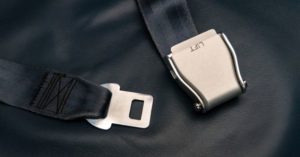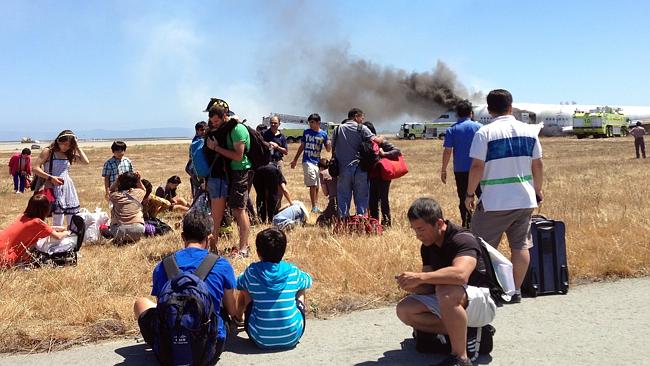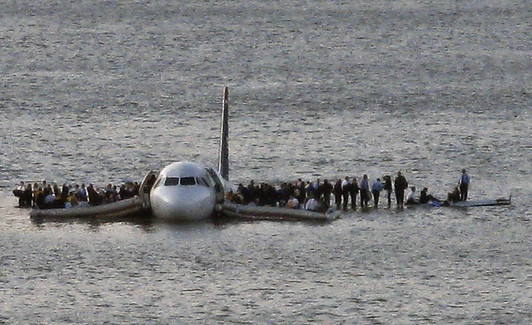- “Ladies and gentlemen, the Captain has turned on the Fasten Seat Belt sign. If you haven’t already done so, please stow your carry-on luggage underneath the seat in front of you or in an overhead bin. Please take your seat and fasten your seat belt. And also make sure your seat back and folding trays are in their full upright position.
For many passengers the start of the safety briefing is a sign they can start dozing, reading or texting.
Are safety announcements an anachronism?
Accounts of US Air Flight 1549‘s evacuation indicate that one of the key reasons many passengers were able to quickly escape when the plane hit the water was down to one passenger. As one passenger attempted to pull the emergency door into the plane, another intervened saying ‘No, you’ve got to throw it out.” This was because he had paid attention during the briefing.
My action: Even after 1013 flights I force myself to engage with the safety briefing. Just as the pilots rehearse their safety, this is my time to listen.

Seatbelt: Prepare for Panic
“When the seat belt sign illuminates, you must fasten your seat belt. Insert the metal fittings one into the other, and tighten by pulling on the loose end of the strap. To release your seat belt, lift the upper portion of the buckle.”
Unsurprisingly in an accident, people panic. What is surprising is that many passengers as a result of that panic, forget how to release their seat belt. Following the 1992 crash of US Airways flight 405, which landed in the water after take off from New York’s LaGuardia Airport, The U.S. National Transportation Safety Board noted, “Some passengers tried to move from their seats while their seatbelts were still buckled, and other passengers had difficulty locating and releasing their seatbelt buckles because of disorientation.”
My action: You will see me buckle and unbuckle the seatbelt three times during the safety drill to remind myself of where it is and how it works. Then I tighten the belt ready for takeoff.
Emergency Exits
Please take a few moments now to locate your nearest exit. In some cases, your nearest exit may be behind you.
When a plane comes down, the crew’s evacuation goal is to empty a full plane in 90 seconds. I want to be in that 90 seconds. Australia’s CASA (Civil Aviation Safety Authority) notes that: “Over 70% of airline accidents are survivable. 71% of people who die in survivable crashes, do so after the aircraft comes to a complete stop.” On the clear San Francisco morning of July 6, 2013, there was no sign that Asiana’s Boeing 777 aircraft would be lying in pieces with smoke pouring out of it. When the plane crashed, many passengers at the back of the plane were not aware of what to do in an evacuation.
My action: I do count the rows to the exit seat in front of me and behind me. I wear trousers and closed in shoes which will protect my legs and feet if I am going through a burning plane or down the slides. In a smoke-filled cabin, it is recommended that one breathes through a piece of your clothing to filter out the smoke.
Oxygen Mask
If you are travelling with a child or someone who requires assistance, secure your mask on first, and then assist the other person.
I have only seen the oxygen masks deployed once. This was on the ground and was a technical failure! In the air, the deployment will be accompanied by a sudden and severe vibration, an automatic automated announcement telling you to put your mask on and a very steep descent by the plane. The scary thing is that sometimes the oxygen in the plane can drop in 15 or 20 seconds and in 30 to 45 seconds you can pass out.
My action: I need to be able to get your mask on quickly if necessary over both my nose and mouth.
Brace Position.
There have been myths surrounding that the brace procedure that is only useful for preserving dental integrity for identification after a crash or designed to increase the chance of death to reduce insurance-paid medical cost. Not so. In a report on British Midlands 1989 Boeing 737 crash: “Passengers who adopted the fully flexed “brace” position for crash-landing achieved significant protection against head injury, concussion, and injuries from behind irrespective of local aircraft structural damage”
CASA notes that “Hands placed one on top of the other and on top of the head. Fingers should not be interlocked.” Should something fall on you during a crash landing, you want to protect at least one hand (preferably the one you write with) because you’ll need it to unbuckle your seat belt when it’s safe to do so. Your other hand is in that position to provide some protection to your “strong” hand, which will be doing the unbuckling. This protects the head from flying debris.
My action: work out how to do the brace position in my seat on each flight
Life vest/jacket
A life jacket is located in a pouch under your seat or between the armrests.
Of the passengers on the US airways plane that ditched into the Hudson, 140 of the 150 passengers failed to grab their life jackets. “Many passengers reported that their immediate concern after the water impact was to evacuate as quickly as possible, that they forgot about or were unaware that a life vest was under their seat…Other passengers stated that they wanted to retrieve their life vest but could not remember where it was stowed.” This is a reminder that panic in a crash will lead to mistakes. Another good reason to focus during the briefing.
The NTSB notes that, “after exiting the airplane through the overwing exits, at least nine passengers unintentionally fell into the water from the wings,”
My Action: I have got into a habit of checking to see if the jacket is there during the safety briefing. A friend of someone I know used to steal life jackets from planes as a bizarre souvenir. It can take an airline a while to find that a jacket has been taken. I want to know mine is there and that I can remember the spot it was in case it is dark or there is smoke.
Bottom Line
I hope I don’t find myself in a crash (as I hope you don’t). The chances are rare but if it happens, I want to be ready.
Related Posts




Nice reminders! I also attempt to demonstrate interest in the safety briefing. I will pull out the safety card and look at it. This is more effective when I’m riding in uniform in the back.
I often here people laugh at the seat belt reminder. But when panic sets in, many people can’t get the belts unbuckled.
In 1985, in Manchester, England, a British Airtours flight aborted a takeoff after an engine failure on takeoff. Fire spread rapidly through the B-737. Of the 131 passengers, 53 passengers and 2 crew members died, mostly due to smoke inhalation.
Many couldn’t get out of the seats to escape the smoke.
Bryan
B737 airline pilot